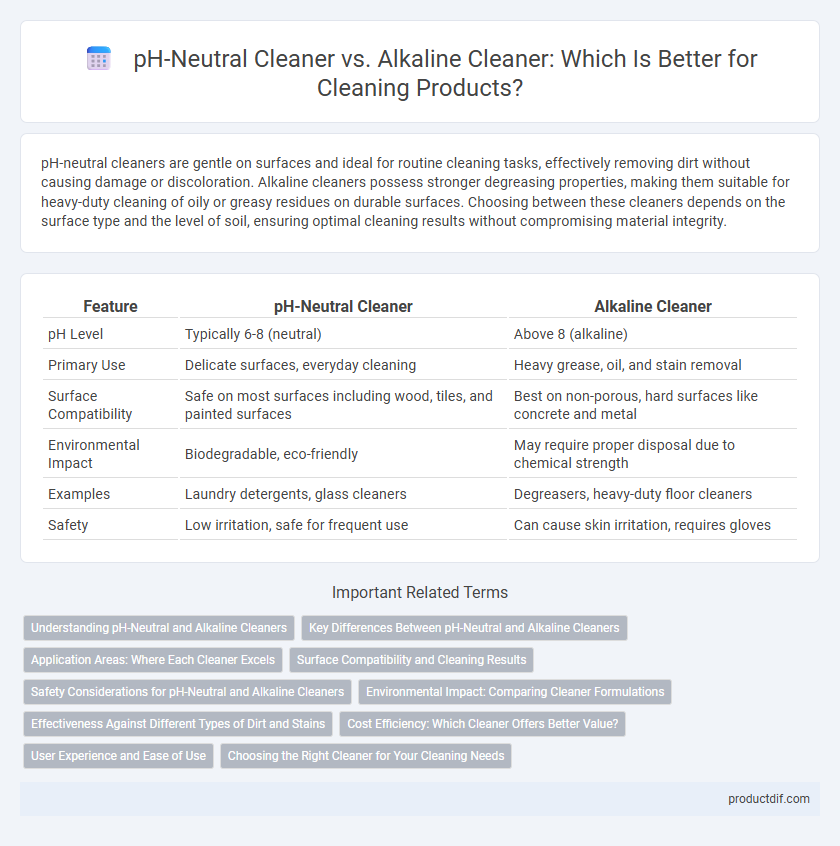pH-neutral cleaners are gentle on surfaces and ideal for routine cleaning tasks, effectively removing dirt without causing damage or discoloration. Alkaline cleaners possess stronger degreasing properties, making them suitable for heavy-duty cleaning of oily or greasy residues on durable surfaces. Choosing between these cleaners depends on the surface type and the level of soil, ensuring optimal cleaning results without compromising material integrity.
Table of Comparison
| Feature | pH-Neutral Cleaner | Alkaline Cleaner |
|---|---|---|
| pH Level | Typically 6-8 (neutral) | Above 8 (alkaline) |
| Primary Use | Delicate surfaces, everyday cleaning | Heavy grease, oil, and stain removal |
| Surface Compatibility | Safe on most surfaces including wood, tiles, and painted surfaces | Best on non-porous, hard surfaces like concrete and metal |
| Environmental Impact | Biodegradable, eco-friendly | May require proper disposal due to chemical strength |
| Examples | Laundry detergents, glass cleaners | Degreasers, heavy-duty floor cleaners |
| Safety | Low irritation, safe for frequent use | Can cause skin irritation, requires gloves |
Understanding pH-Neutral and Alkaline Cleaners
pH-neutral cleaners have a balanced pH of around 7, making them gentle and safe for most surfaces including sensitive materials like wood and natural stone. Alkaline cleaners possess a higher pH, typically between 8 and 14, enabling them to effectively break down grease, oils, and heavy soils on tough industrial or kitchen surfaces. Choosing between pH-neutral and alkaline cleaners depends on the cleaning task, surface type, and desired level of soil removal without damaging the material.
Key Differences Between pH-Neutral and Alkaline Cleaners
pH-neutral cleaners maintain a balanced pH close to 7, making them gentle on surfaces and suitable for routine cleaning without causing damage or discoloration. Alkaline cleaners have a higher pH, typically above 9, enabling them to break down grease, oils, and heavy soils more effectively but potentially harming sensitive materials. Understanding these differences is crucial for selecting the right product based on surface type and cleaning requirements to ensure optimal results and protection.
Application Areas: Where Each Cleaner Excels
pH-neutral cleaners excel in cleaning delicate surfaces such as hardwood floors, natural stone, and painted walls where maintaining surface integrity is crucial. Alkaline cleaners are highly effective in heavy-duty applications like removing grease, oil, and organic residues in industrial kitchens, automotive workshops, and manufacturing plants. Selecting the appropriate cleaner depends on the surface type and the nature of the soil to ensure optimal cleaning performance without damage.
Surface Compatibility and Cleaning Results
pH-neutral cleaners are ideal for delicate surfaces such as wood, laminate, and painted finishes, offering effective cleaning without causing damage or discoloration. Alkaline cleaners excel at breaking down grease, oil, and heavy soils on tough surfaces like concrete and metal, providing powerful cleaning results but posing a risk to sensitive materials. Selecting the right cleaner ensures optimal surface compatibility and enhances overall cleaning performance while preserving the integrity of the material.
Safety Considerations for pH-Neutral and Alkaline Cleaners
pH-neutral cleaners offer enhanced safety due to their balanced pH, reducing risks of skin irritation and respiratory issues commonly associated with alkaline cleaners. Alkaline cleaners, with a higher pH, can effectively break down grease and organic materials but require careful handling, protective equipment, and proper ventilation to prevent chemical burns and inhalation hazards. Selecting the appropriate cleaner involves evaluating the cleaning task alongside safety protocols to ensure effective and safe usage.
Environmental Impact: Comparing Cleaner Formulations
pH-neutral cleaners typically have a lower environmental impact due to their gentler formulation, which minimizes water pollution and reduces harm to aquatic life. In contrast, alkaline cleaners often contain stronger chemicals that can increase water alkalinity and contribute to ecosystem disruption if not properly treated. Choosing pH-neutral products supports sustainable cleaning practices and helps maintain ecological balance by reducing toxic residue and chemical runoff.
Effectiveness Against Different Types of Dirt and Stains
pH-neutral cleaners effectively remove light dirt, dust, and organic stains without damaging sensitive surfaces such as wood, laminate, and painted finishes. Alkaline cleaners excel at breaking down heavy grease, oils, and protein-based stains found in kitchens and industrial settings due to their higher pH and stronger chemical action. Selecting the appropriate cleaner based on the dirt type ensures optimal cleaning performance while preserving surface integrity.
Cost Efficiency: Which Cleaner Offers Better Value?
pH-neutral cleaners typically offer better cost efficiency for routine cleaning as they require less protective equipment and reduce the risk of surface damage, lowering long-term maintenance costs. Alkaline cleaners, while more aggressive on tough grime and grease, often necessitate higher usage rates and additional safety measures, increasing overall expenses. Evaluating cleaning frequency, surface type, and safety requirements helps determine which cleaner provides the best value for specific applications.
User Experience and Ease of Use
pH-neutral cleaners offer a gentle formula that is safe for a wide range of surfaces and reduces skin irritation, making them ideal for everyday use and sensitive users. Alkaline cleaners provide powerful grease and grime removal but may require gloves and proper ventilation due to their stronger chemical composition. Users often prefer pH-neutral options for their ease of handling and minimal safety precautions, enhancing overall user comfort and convenience.
Choosing the Right Cleaner for Your Cleaning Needs
pH-neutral cleaners provide gentle cleaning suitable for delicate surfaces such as hardwood, tile, and painted walls, ensuring safety without damaging finishes or causing discoloration. Alkaline cleaners excel in breaking down grease, oils, and heavy-duty grime on hard surfaces like concrete, stainless steel, and kitchen appliances, offering powerful stain removal and degreasing capabilities. Selecting between pH-neutral and alkaline cleaners depends on the surface type and soil level, with pH-neutral ideal for routine maintenance and sensitive materials, while alkaline is preferred for tough cleaning tasks requiring strong chemical action.
pH-neutral cleaner vs Alkaline cleaner Infographic

 productdif.com
productdif.com